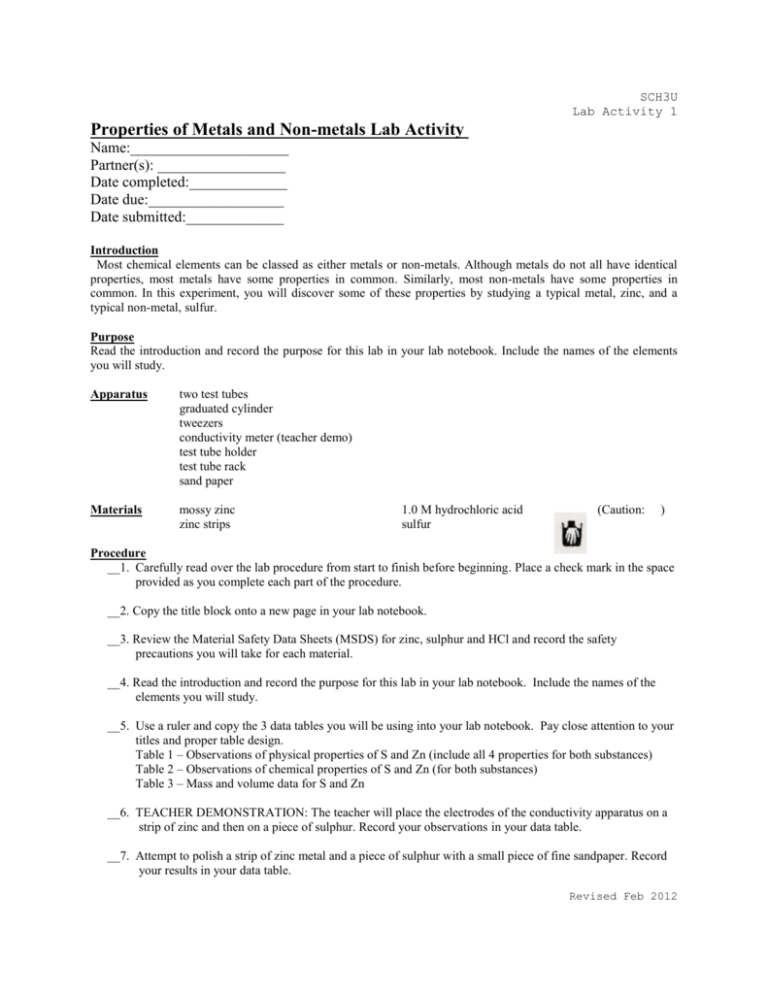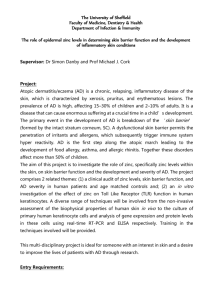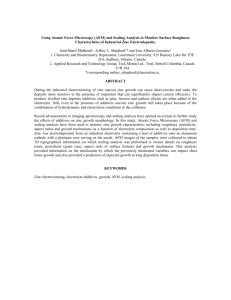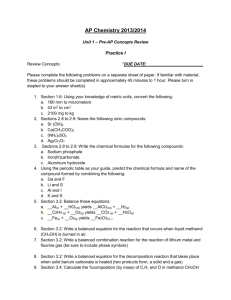Lab 1.1 Properties of Metals and Nonmetals Revised Feb 2012
advertisement

SCH3U Lab Activity 1 Properties of Metals and Non-metals Lab Activity Name:_____________________ Partner(s): _________________ Date completed:_____________ Date due:__________________ Date submitted:_____________ Introduction Most chemical elements can be classed as either metals or non-metals. Although metals do not all have identical properties, most metals have some properties in common. Similarly, most non-metals have some properties in common. In this experiment, you will discover some of these properties by studying a typical metal, zinc, and a typical non-metal, sulfur. Purpose Read the introduction and record the purpose for this lab in your lab notebook. Include the names of the elements you will study. Apparatus two test tubes graduated cylinder tweezers conductivity meter (teacher demo) test tube holder test tube rack sand paper Materials mossy zinc zinc strips 1.0 M hydrochloric acid sulfur (Caution: ) Procedure __1. Carefully read over the lab procedure from start to finish before beginning. Place a check mark in the space provided as you complete each part of the procedure. __2. Copy the title block onto a new page in your lab notebook. __3. Review the Material Safety Data Sheets (MSDS) for zinc, sulphur and HCl and record the safety precautions you will take for each material. __4. Read the introduction and record the purpose for this lab in your lab notebook. Include the names of the elements you will study. __5. Use a ruler and copy the 3 data tables you will be using into your lab notebook. Pay close attention to your titles and proper table design. Table 1 – Observations of physical properties of S and Zn (include all 4 properties for both substances) Table 2 – Observations of chemical properties of S and Zn (for both substances) Table 3 – Mass and volume data for S and Zn __6. TEACHER DEMONSTRATION: The teacher will place the electrodes of the conductivity apparatus on a strip of zinc and then on a piece of sulphur. Record your observations in your data table. __7. Attempt to polish a strip of zinc metal and a piece of sulphur with a small piece of fine sandpaper. Record your results in your data table. Revised Feb 2012 SCH3U Lab Activity 1 __8. Attempt to gently bend a strip of zinc metal. Attempt to bend a piece of sulfur. Record your observations. __9. Find the melting points of sulphur and zinc on the Periodic Table. Watch a video clip of each element being heated. Record your observations. __10. Measure approximately 3 mL of 1 M hydrochloric acid into each of two test tubes. Place a piece of sulphur the size of a match head in one test tube and a small piece of mossy zinc in the other. Record your observations before, during and after the reaction. __11. Considering significant digits, design a method to determine the density of both sulphur and zinc. __12. Carry out the procedure you designed in step 11. __13. Return all equipment to its proper location. Dispose of the chemicals as directed by your teacher. Finally, wipe your lab bench with a paper towel and then return to your seat to work on completing the lab report. __14. In your lab book, calculate the density of sulphur and zinc. Show the formula you used, carry all units and keep significant digits in mind. __15. Look up known density values for sulphur and zinc. __16. Write your discussion in paragraph form. Reflect on the ‘Guiding Questions for Discussion’ before you begin writing. __17. Read the rubric carefully and check each box you have completed. Revised Feb 2012 SCH3U Lab Activity 1 Properties of Metals and Non-metals Lab Activity Rubric Level 1 Level 2 Level 3 Level 4 Communication Title Block - appropriate title - name and partner(s) name(s) - date lab performed - date lab due Purpose - appropriate purpose is given - materials being tested are mentioned Data Table - appropriate title at the top - well organized and neat - numbers are aligned - units are in the headings only - contains all relevant data Organizes information with limited effectiveness Organizes information with some effectiveness Organizes information with considerable effectiveness Organizes information with a high degree of effectiveness Purpose is communicated with limited effectiveness Purpose is communicated with some effectiveness Purpose is communicated with considerable effectiveness Purpose is communicated with a high degree of effectiveness Organizes information with limited effectiveness Organizes information with some effectiveness Organizes information with considerable effectiveness Organizes information with a high degree of effectiveness Observations are communicated with limited effectiveness Observations are communicated with some effectiveness Observations are communicated with considerable effectiveness Observations are communicated with a high degree of effectiveness Overall Communication -use of conventions, vocabulary, terminology Uses conventions, vocabulary and terminology with limited effectiveness Uses conventions, vocabulary and terminology with some effectiveness Uses conventions, vocabulary and terminology with considerable effectiveness Uses conventions, vocabulary and terminology with a high degree of effectiveness Communication /20 Inquiry Experimental Technique - accuracy of the results - safety in the lab Applies knowledge of laboratory technique and safety with limited effectiveness Applies knowledge of laboratory technique and safety with some effectiveness Calculates density with some effectiveness Applies knowledge of laboratory technique and safety with considerable effectiveness Calculates density with considerable effectiveness Applies knowledge of laboratory technique and safety with a high degree of effectiveness Calculates density with a high degree of effectiveness Calculation of Density - all units are carried - correct formula is used - significant digits are considered Discussion - general properties of metals and non-metals compared -general properties of metals and non-metals are explained Calculates density with limited effectiveness Few conclusions are made on the basis of evidence Some conclusions are made on the basis of evidence Most conclusions are made on the basis of evidence All conclusions are made on the basis of evidence Few conclusions are explained Some conclusions are explained Most conclusions are explained All conclusions are explained - density is compared to known values and reasons for discrepancies are discussed Evaluates data with limited effectiveness Evaluates data with some effectiveness Evaluates data with considerable effectiveness Evaluates data with a high degree of effectiveness Inquiry /20 Revised Feb 2012 SCH3U Lab Activity 1 Table 1: Observations of physical properties of zinc and sulfur Zinc Sulfur Conductivity Lustre Malleability Melting Point Table 2: Observations of reactivity of zinc and sulfur with hydrochloric acid Zinc Sulfur Before Reaction During Reaction After Reaction Table 3: Mass, volume and density of zinc and sulfur Zinc Sulfur Mass (g) Volume of H2O displaced (mL) Revised Feb 2012 SCH3U Lab Activity 1 Guiding Questions for Discussion - How does the electrical conductivity of sulfur compare with that of zinc? How do you know? How does the lustre of sulfur compare with that of zinc? Explain how you know. How does the malleability of sulfur compare with that of zinc? Explain how you know. What can you say about the relative melting points of sulfur and of zinc? What is your evidence for this? How does the reactivity of sulfur with hydrochloric acid compare the reactivity of zinc with hydrochloric acid? Look up the known density values for S and Zn. Compare your results for density with the known values. Discuss reasons for any discrepancies. Revised Feb 2012






